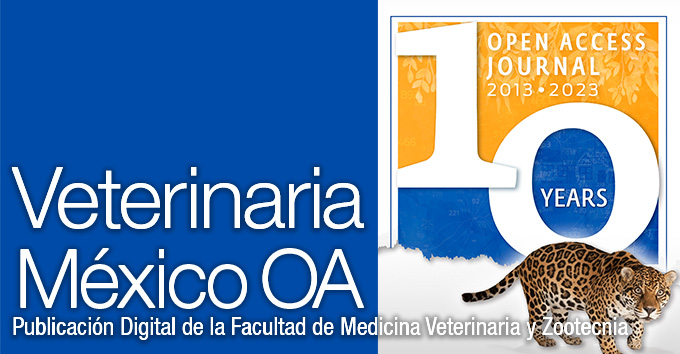Pet transportation or tourism: risk of moving zoonotic pathogens
Main Article Content
Abstract
Pet transportation has become relevant. However, since adequate sanitary measures are not taken, pets can be carriers of pathogens, such as ticks which at the same time may turn into zoonotic agent vectors. Ticks are frequent ectoparasites in warm areas. However, they may be dispersed in temperate regions such as Mexico City (CDMX) and become responsible for other vector-borne diseases relevant to Veterinary Medicine and/or public health. It shows that moving animals from one place to another, including tourism with pets, can cause dispersion and proliferation of pathogens if the adequate sanitary measures are not taken. Therefore, this article is of great importance from a biological, ecological, public and veterinary health, since it shows the role of humans in the spread of pathogens particularly of Rhipicephalus sanguineus, its introduction to a site otherwise naturally free of them, and the adaptation mechanisms they may display to infect other hosts with the potential to transmit other emerging pathogens.
Article Details
References
Villarreal Z, Stephenson N, Foley J. Possible Northward Introgression of a Tropical Lineage of Rhipicephalus sanguineus Ticks at a Site of Emerging Rocky Mountain Spotted Fever. The Journal of parasitology. 2018;104(3):240-245. doi: 10.1645/18-10
Castillo-Martínez A, Cueto-Medina S, Hernández-Rodríguez S. Detección de Rickettsia sp. en la garrapata café del perro Rhipicephalus sanguineus (Acari: Ixodidae) en Matamoros, Coahuila, México. Acta Zoológica Mexicana. 2015;31(1):80-83.
Tinoco-Gracia L, Lomelí MR, Hori-Oshima S. Molecular Confirmation of Rocky Mountain Spotted Fever Epidemic Agent in Mexicali, Mexico. Emerging infectious diseases. 2018;24(9):1723-1725. doi: 10.3201/eid2409.171523.
Pat-Nah H, Rodriguez-Vivas RI, Bolio-Gonzalez ME. Molecular Diagnosis of Ehrlichia canis in Dogs and Ticks Rhipicephalus sanguineus (Acari: Ixodidae) in Yucatan, Mexico. Journal of medical entomology. 2015;52(1):101-4. doi: 10.1093/jme/tju010,
Almazán C, González-Álvarez V, Fernández de Mera I. Molecular identification and characterization of Anaplasma platys and Ehrlichia canis in dogs in Mexico. Ticks and tick-borne diseases. 2016;7(2):276-283. doi: 10.1016/j.ttbdis.2015.11.002.
Ojeda-Chi MM, Rodriguez-Vivas RI, Esteve-Gasent MD. Ticks infesting dogs in rural communities of Yucatan, Mexico and molecular diagnosis of rickettsial infection. Transboundary and emerging diseases. 2019;66(1):102-110. doi: 10.1111/tbed.1299.
Sosa-Gutiérrez C, Quintero-Martinez T, Vargas-Sandoval M. First phylogenetic analysis of Ehrlichia canis in dogs and ticks from Mexico Preliminary study. Revista MVZ Córdoba. 2016; 21(3):5569-5576.
Gray J, Dantas-Torres F, Estrada-Peña A, Levin M. Systematics and ecology of the brown dog tick, Rhipicephalus sanguineus. Ticks and tick-borne diseases. 2013;4(3):171-80. doi: 10.1016/j.ttbdis.2012.12.003
Cruz-Vazquez C, Garcia-Vazquez Z. Seasonal distribution of Rhipicephalus sanguineus ticks (Acari: Ixodidae) on dogs in an urban area of Morelos, Mexico. Experimental & applied acarology. 1999;23(3):277-80. doi: 10.1023/a:1006075232455
Dantas-Torres F. Biology and ecology of the brown dog tick, Rhipicephalus sanguineus. Parasites & Vectors. 2010;26(3). doi: 10.1186/1756-3305-3-26.
SEDEMA (Secretaría del Medio Ambiente). Localización geográfica de la Ciudad de México. 2015. http://data.sedema.cdmx.gob.mx/biodiversidadcdmx/geografia.html
Bowman DD. Parasitología para Veterinarios. 11 th. New York: Saunders, Elsevier; 2011.
Pérez-Ponce de León G, Pinacho-Pinacho C, Mendoza-Garfias B. Phylogenetic Analysis Using the 28S rRNA Gene Reveals That the Genus Paracreptotrema (Digenea: Allocreadiidae) Is Not Monophyletic; Description of Two New Genera and One New Species. The Journal of parasitology. 2016;102(1):131–142. doi: 10.1645/15-815.
Martínez-Medina MA, Álvarez-Hernández G, Padilla-Zamudio JG. Fiebre Manchada de las Montañas Rocosas en niños: consideraciones clínicas y epidemiológicas. Gaceta Médica de México. 2007;143(2):137-140.
Castillo-Martínez A, Cueto-Medina S, Valdés-Perezgasga M. Detección de Rickettsia rickettsii Brumpt (Rickettsiales: Rickettsiaceae) en la garrapata café del perro Rhipicephalus sanguineus Latreille (Ixodida: Ixodidae) en la Comarca Lagunera, zona reemergente de Fiebre Manchada en México. Acta Zoológica Mexicana. 2017;33(2).
License

Veterinaria México OA by Facultad de Medicina Veterinaria y Zootecnia - Universidad Nacional Autónoma de México is licensed under a Creative Commons Attribution 4.0 International Licence.
Based on a work at http://www.revistas.unam.mx
- All articles in Veterinaria México OA re published under the Creative Commons Attribution 4.0 Unported (CC-BY 4.0). With this license, authors retain copyright but allow any user to share, copy, distribute, transmit, adapt and make commercial use of the work, without needing to provide additional permission as long as appropriate attribution is made to the original author or source.
- By using this license, all Veterinaria México OAarticles meet or exceed all funder and institutional requirements for being considered Open Access.
- Authors cannot use copyrighted material within their article unless that material has also been made available under a similarly liberal license.



